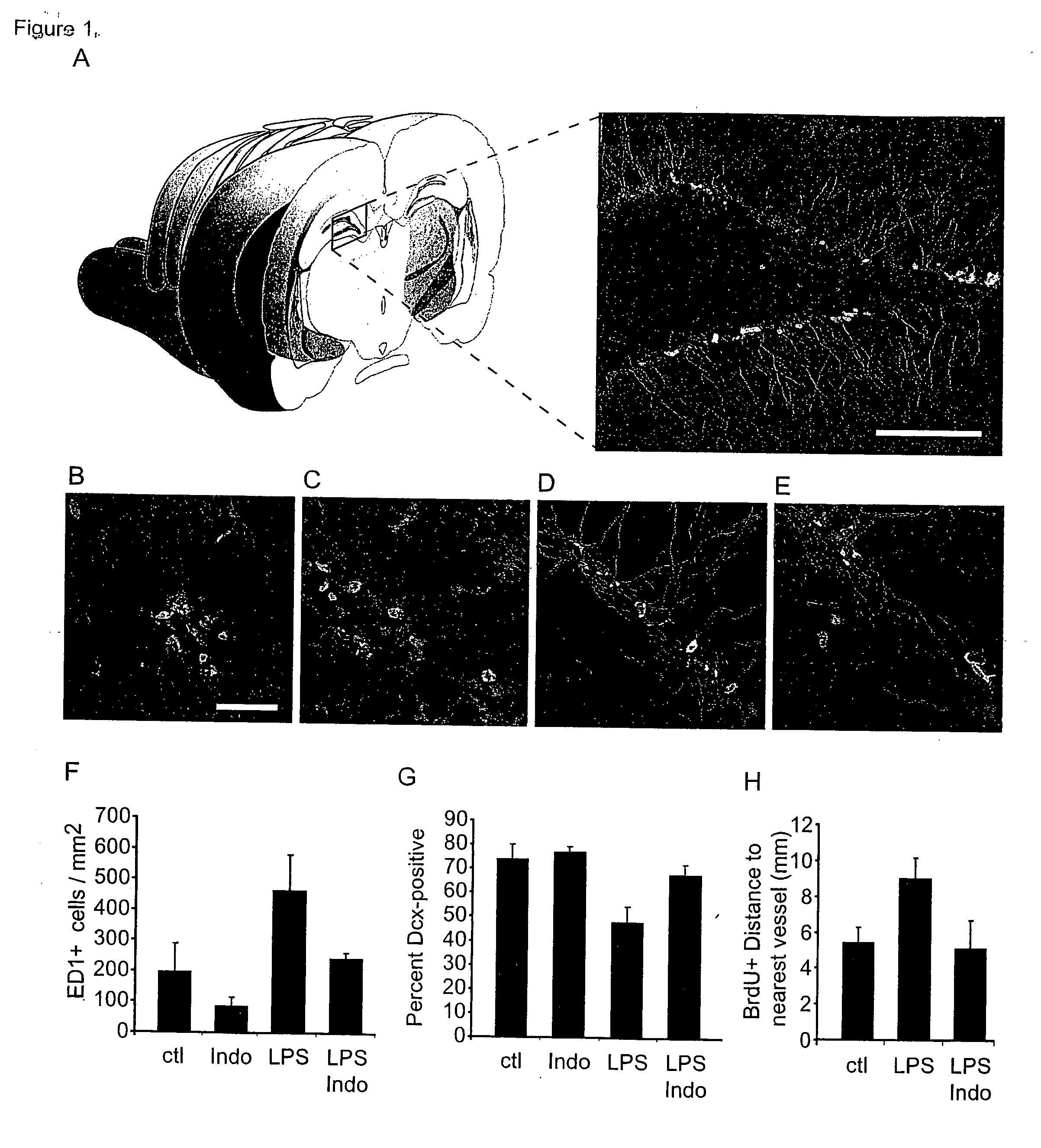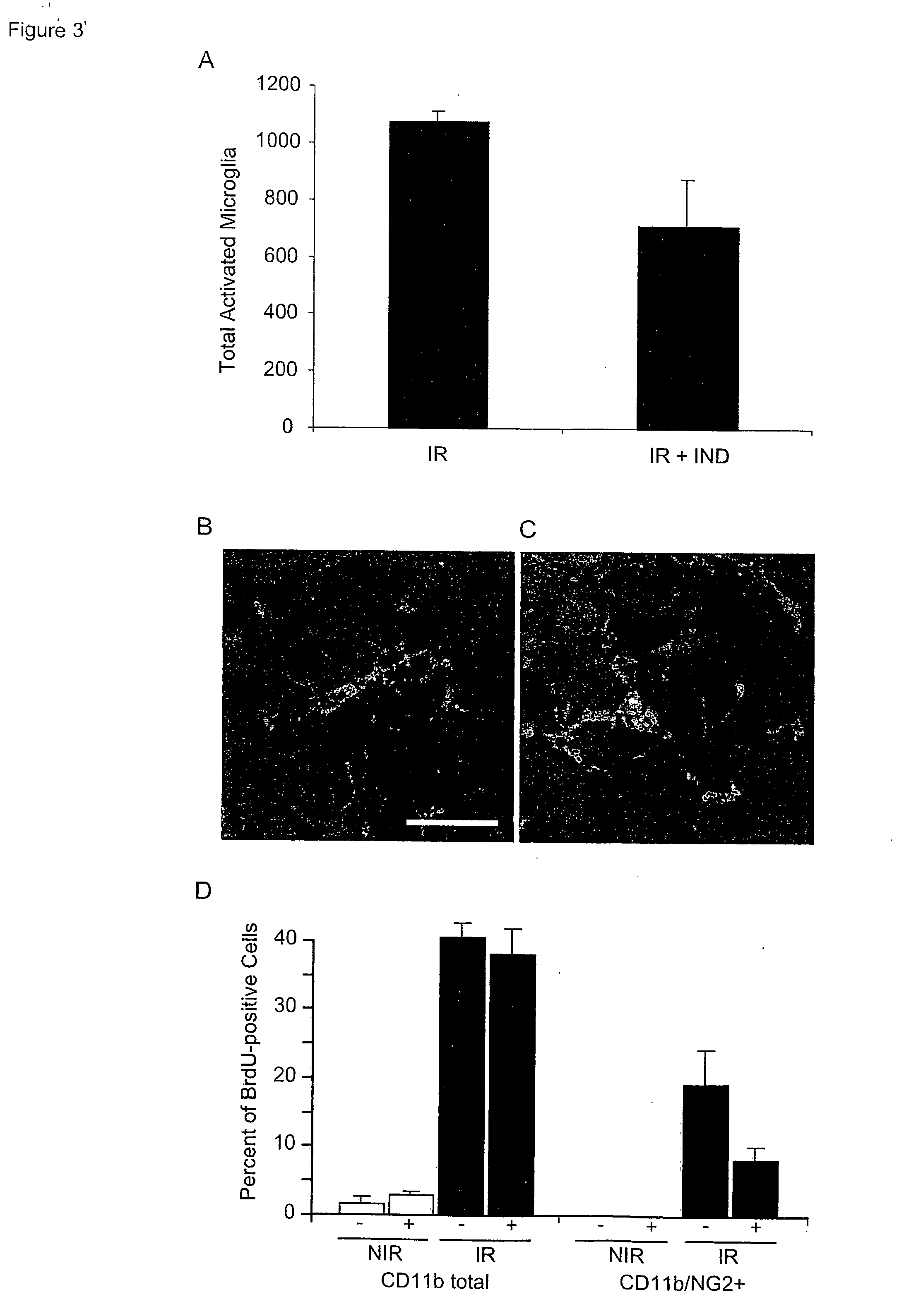Prevention of deficits in neurogenesis with anti-inflammatory agents
a neurogenesis and anti-inflammatory agent technology, applied in the direction of drug compositions, peptide/protein ingredients, therapy, etc., can solve the problems of affecting neuronal precursor cell differentiation, and particularly harmful activation of microglial cells, so as to prevent or diminish neurogenesis capacity loss, block the effect of cytokines
- Summary
- Abstract
- Description
- Claims
- Application Information
AI Technical Summary
Benefits of technology
Problems solved by technology
Method used
Image
Examples
example 1
[0088] Cranial radiation therapy causes a progressive decline in cognitive function that is inked to impaired neurogenesis.
[0089] Chronic inflammation accompanies radiation injury, indicating that inflammatory processes may contribute to neural stem cell dysfunction. The following data demonstrate that neuroinflammation alone inhibits neurogenesis and that inflammatory blockade with indomethacin, a common nor steroidal anti-inflammatory drug, restores neurogenesis following endotoxin-induced inflammation and augments neurogenesis following cranial irradiation.
[0090] To determine the effects of inflammation on adult hippocampal neurogenesis, bacterial lipopolysaccharide (LPS) was injected into adult female rats to induce systemic inflammation. The intraperitoneal administration of LPS causes a peripheral inflammatory cascade that is transduced to the brain via IL-1β from the cerebral vasculature and causes a strong upregulation of central pro-inflammatory cytokine production. Follo...
example 2
Behavioral Aspects of Inflammation-induced Deficits
[0124] LPS-induced inflammatory response impairs performance in the Barnes maze. It has been reported previously that irradiation and LPS-induced inflammation impair performance in hippocampus-dependent spatial tasks. The present studies confirm that LPS treatment impaired recall of a goal position learned prior to LPS treatment. The Barnes maze is a 6-foot diameter bright white platform with 8 escape boxes under holes in the rim of the platform. All escape holes are blocked except one and the rat is initially placed in the goal box for familiarization. The rat is then placed in the center of the maze and is allowed to find its way back to the goal box to escape the aversive brightly lit platform. Learning is seen as a decrease in the distance traveled to reach the goal box with consecutive trials on a given day and in repeat sessions on sequential days. One measure of recall is to determine distance traveled when the animal is tes...
example 3
The Chemokine Monocyte Chemoattractant Protein-1 (MCP-1) is Necessary for Irradiation-induced Inhibition of Neurogenesis
[0134] Neuroinflammation inhibits adult hippocampal neurogenesis through both a specific block in neuronal differentiation and a generalized decrease in newborn cell survival. As shown above, anti-inflammatory therapy with the NSAID indomethacin restores neurogenesis following cranial radiation exposure. Because one of the most robust effects of indomethacin treatment was to decrease the number of infiltrating blood monocytes, the population of recruited monocytes / macrophage may be an important component of the neuroinflammatory response to irradiation, and recruited monocytes / macrophages may play a pivotal role in inflammatory inhibition of neurogenesis.
[0135] Monocyte chemoattractant protein-1 (MCP-1) is a CC family chemokine (i.e., chemoattractant cytokine), Rollins (1997) Blood 90, 909-928, that is produced by astrocytes and microglia in response to injury or...
PUM
 Login to View More
Login to View More Abstract
Description
Claims
Application Information
 Login to View More
Login to View More - R&D
- Intellectual Property
- Life Sciences
- Materials
- Tech Scout
- Unparalleled Data Quality
- Higher Quality Content
- 60% Fewer Hallucinations
Browse by: Latest US Patents, China's latest patents, Technical Efficacy Thesaurus, Application Domain, Technology Topic, Popular Technical Reports.
© 2025 PatSnap. All rights reserved.Legal|Privacy policy|Modern Slavery Act Transparency Statement|Sitemap|About US| Contact US: help@patsnap.com



